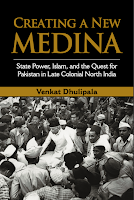 |
Rama and Narada praying to Durga
(Kolkata Durgotsava)
|
Best wishes for a joyous Navratri. May Goddess Durga illuminate your life with blessings of happiness. Here’s the English translation of Durga Stotra (Hymn to Durga) written by Sri Aurobindo in Bengali in 1909:
Durga Stotra
Mother Durga! Rider on the lion, giver of all strength, Mother, beloved of Shiva! We, born from thy parts of Power, we the youth of India, are seated here in thy temple. Listen, O Mother, descend upon earth, make thyself manifest in this land of India.
Mother Durga! From age to age, in life after life, we come down into the human body, do thy work and return to the Home of Delight. Now too we are born, dedicated to thy work. Listen, O Mother, descend upon earth, come to our help.
Mother Durga! Rider on the lion, trident in hand, thy body of beauty armour-clad, Mother, giver of victory. India awaits thee, eager to see the gracious form of thine. Listen, O Mother, descend upon earth, make thyself manifest in this land of India.
Mother Durga! Giver of force and love and knowledge, terrible art thou in thy own self of might, Mother beautiful and fierce. In the battle of life, in India's battle, we are warriors commissioned by thee; Mother, give to our heart and mind a titan's strength, a titan's energy, to our soul and intelligence a god's character and knowledge.
Mother Durga! India, world's noblest race, lay whelmed in darkness. Mother, thou risest on the eastern horizon, the dawn comes with the glow of thy divine limbs scattering the darkness. Spread thy light, Mother, destroy the darkness.
Mother Durga! We are thy children, through thy grace, by thy influence may we become fit for the great work, for the great Ideal. Mother, destroy our smallness, our selfishness, our fear.
Mother Durga! Thou art Kali, naked, garlanded with human heads, sword in hand, thou slayest the Asura. Goddess, do thou slay with thy pitiless cry the enemies who dwell within us, may none remain alive there, not one. May we become pure and spotless, this is our prayer. O Mother, make thyself manifest.
Mother Durga! India lies now in selfishness and fearfulness and littleness. Make us great, make our efforts great, our hearts vast, make us true to our resolve. May we no longer desire the small, void of energy, given to laziness, stricken with fear.
Mother Durga! Extend wide the power of Yoga. We are thy Aryan children, develop in us again the lost teaching, character, strength of intelligence, faith and devotion, force of austerity, power of chastity and true knowledge, bestow all that upon the world. To help mankind, appear, O Mother of the world, dispel all ills.
Mother Durga! Slay the enemy within, then root out all obstacles outside. May the noble heroic mighty Indian race, supreme in love and unity, truth and strength, arts and letters, force and knowledge ever dwell in its holy woodlands, its fertile fields under its sky-scraping hills, along the banks of its pure-streaming rivers. This is our prayer at the feet of the Mother. Make thyself manifest.
Mother Durga! Enter our bodies in thy Yogic strength. We shall become thy instruments, thy sword slaying all evil, thy lamp dispelling all ignorance. Fulfil this yearning of thy young children, O Mother. Be the master and drive the instrument, wield thy sword and slay the evil, hold up the lamp and spread the light of knowledge. Make thyself manifest.
Mother Durga! When we possess thee, we shall no longer cast thee away; we shall bind thee to us with the tie of love and devotion. Come, Mother, manifest in our mind and life and body.
Come, Revealer of the hero-path. We shall no longer cast thee away. May our entire life become a ceaseless worship of the Mother, all our acts a continuous service to the Mother, full of love, full of energy. This is our prayer, O Mother, descend upon earth, make thyself manifest in this land of India.











_During_Yanglaj_Yatra_2017_Photo_by_Aliraza_Khatri.jpg)















